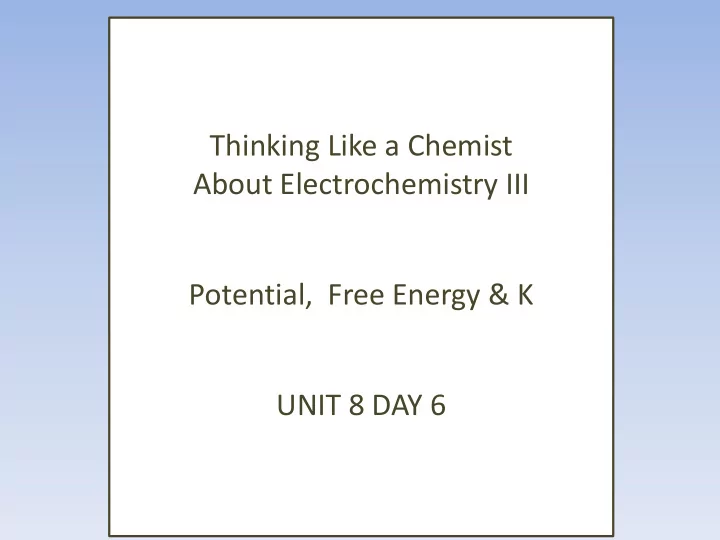

Thinking Like a Chemist About Electrochemistry III Potential, Free Energy & K UNIT 8 DAY 6
What are we going to learn today? Determine Voltage in Electrochemical Cells Containing Different Concentrations of Reactants Relationship between ΔG, E, and K Applications of Electrochemistry: Membrane Potential
REVIEW FROM LAST CLASS Relationship between E and ∆G ∆G is energy E is electrical potential Electric work (energy) = charge X potential work = -charge X E ∆G = work max ∆G = - charge X E max From now on we’ll know the Potential we calculate is the theoretical maximum Real world never actually that good ∆G = - nFE
Work on PART 2 of “Extracting Work from Chemical Change” Activity, starting on #7
Poll: Clicker Question #7: What is the maximum amount of electrical work that can be extracted from running this cell under standard conditions. A. 2316 kJ/mol B. 1158 kJ/mol C. 579 kJ/mol D. 239 kJ/mol
Poll: Clicker Question #10: What can you say about Q? A. Q<K and reaction will proceed towards products. B. Q<K and reaction will proceed towards reactants. C. Q>K and reaction will proceed towards products. D. Q>K and reaction will proceed towards reactants.
DERIVE NERNST EQUATION -nFE = -nFE ° + RTlnQ
E = Eº - (0.0591/n) log (Q) #12: Calculate the emf of the cell: Al(s)|Al 3+ (aq, 0.001 M) ||Cu 2+ (aq, 0.01 M) |Cu(s) A. 1.8 V B. 1.9 V C. 2 V D. 2.1 V
E = Eº - (0.0591/n) log (Q) #12: Calculate the emf of the cell: Al(s)|Al 3+ (aq, 1 M) ||Cu 2+ (aq, 1 x 10 -8 M) |Cu(s) A. 1.55 V B. 1.76 V C. 2 V D. 2.24 V
Nernst Equation – Dependence of Cell Potential on Concentration E = Eº - (0.0591/n) log (Q) Think about what happens to the value of E when the value of Q changes!
NERNST EQUATION USED TO DETERMINE CONCENTRATION E = Eº - 0.0591 log (Q) n Cu (s) I Cu 2+ (.001M) II Cu 2+ (1M) I Cu (s)
Poll: Clicker Question Nernst Equation – Dependence of Cell Potential on Concentration Calculate the emf of the cell: Cu(s)|Cu 2+ (aq, .001 M) ||Cu 2+ (aq,1 M) |Cu(s) A. +0.176 V B. -0.176 V C. +0.088 V D. -0.088 V E. zero
Poll: Clicker Question Think about why this cell produces a voltage: Cu(s)|Cu 2+ (aq, .001 M) ||Cu 2+ (aq,1 M) |Cu(s) EXPLAIN IN TERMS OF FREE ENERGY HOW THIS CELL PRODUCES A VOLTAGE a) More concentrated cell lower free energy b) Less concentrated cell lower free energy c) Chemical reaction is moving in a direction to maximize free energy
What did we learn today? Calculate the cell potential for a nonstandard cell. Describe fully the relationship between the free energy and the cell potential. Describe fully the relationship between cell potential and the equilibrium constant. Explain thermodynamically the operation of a concentration cell, and be able to predict the concentration in the cell based on the cell potential. Understand the relationship between charge delivered or produced and the amount of reactant used or product formed for both galvanic and electrolytic cells.
IMPORTANT INFORMATION HW 13 posted soon. Course instructor surveys available online! Please take a few minutes to fill one out!
Recommend
More recommend